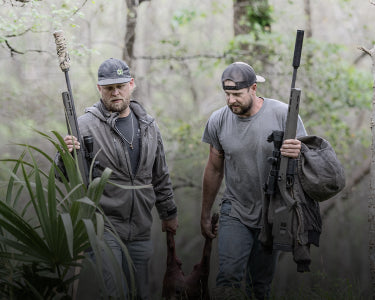The ancient Chinese warrior-poet Sun Tzu once said if one knows both his enemy and himself, in a hundred battles, he will never be defeated. For the hunters of the American South, this enemy is the feral hog.
Where Did All These Hogs Come From?
The Spanish first brought Eurasian wild boar to their New World colonies in the 16th century, with initial expeditions releasing them into the wild for their successors to hunt. This attempt to create a self-sustaining food source resulted in an explosion of hogs across every Spanish colony in the Americas and now the hogs are our problem.
The modern feral hog is the result of an unnatural union between the aforementioned wild boar and the domestic pig. Their vast numbers come from their year-long mating season and the fact they reach sexual maturity at only three months. Sows can produce litters of up to seven pigs, with two litters per year.
Understanding the Enemy: Piglet to Problem
The coat of a feral pig depends on its age. An animal six months or younger is very small, about the size of a Jack Russel terrier or a young lamb. At this stage, it is categorized as a piglet or a “squeaker.” The broad black-and-tan horizontal stripes serve as camouflage against their natural predators but serve no defense against thermal vision.
Why Thermal Beats Night Vision for Hog Hunting
Unlike night vision, thermal optics detect objects based on thermal radiation instead of the amplification of light. Consider that the military’s PVS-14 night vision goggles have a maximum range of about 100-200 yards while Sightmark’s Wraith Mini Thermal has a maximum range of about 1,400 yards without needing to rely on an IR illuminator.
A detection range that far is perfect for shooting from a concealed blind. Many commercial hog hunting ranches have feeders set up near blinds, which are good for efficient hunting, but if you find yourself on any land which allows you to bring your own bait, consider making your own bait.
How to Bait Hogs Effectively
Hogs have poor eyesight, but they have a phenomenal sense of smell. Knowing this, whatever bait you use should be able to carry an aroma. Some whole shelled corn mixed with strong-smelling sugary liquids like soda and a packet of yeast are a great, cheap option for attracting entire sounders.
Shooting Strategy: Do You Shoot the Matriarch?
If and when the hogs finally arrive, they will be led by the matriarch. This is usually the largest and oldest sow in the group who is in charge of caring for the piglets and leading the hogs to food sources. Now, just like people who debate between Whataburger and In-N-Out, there are two camps with differing viewpoints on the fate of the matriarch.
Some people say the matriarch should be sought out and shot, since the sounder would scatter without proper leadership. Others, on the other hand, say the matriarch should never be shot precisely because the sounder will scatter without proper leadership.
Now, where’s the logic there? Way back in the era of musket warfare, soldiers were told not to shoot at enemy officers since an army without a leader would dissolve into a disorderly mob of deserters scattering in all directions that would wreak havoc through indiscriminate looting. The same thing can happen if you shoot a matriarch. If the hogs scatter, there’s a chance some of them will form their own smaller sounders and wreak havoc everywhere. However, at the same time, shooting the matriarch will cause momentary confusion and may even make some younger pigs freeze in panic, making them easier to shoot.
On the other hand, shooting any other pig but the matriarch will make the sounder beat a nice, neat, linear retreat with everyone following the matriarch to safety. The sounder will remain a single entity, with individuals leaving the sounder only in adulthood.
There is also the distinct possibility that shooting a sow with piglets in tow will have the piglets come back immediately after their mother is killed. The sight might tug at the heart strings of some hunters, but in actuality, the piglets are returning to lap at the blood coming from their mother's corpse.
The Intelligence of Feral Hogs
Their ability to form social groups isn’t the only marker of the feral hog’s intelligence. Many say the feral hog is even smarter than the dog. In labs, pigs have demonstrated their ability to solve simple problems that human 2 year olds wouldn’t be able to solve. In the wild, feral pigs have frequently been seen hiding among herds of cattle as a form of camouflage.
In the 1920s, British hunters in India would frequently chase down wild boar on horseback, and the hogs quickly realized that if they hid among cattle, the British would never charge them. In the same way, American hogs mingle among cattle knowing that they won’t be shot as long as the large, valuable beasts are in their way.
Thermal Tech and Concealment
Since hog hunters face such a cunning foe, the act of pig hunting is a challenging activity that requires both careful planning and strategy. To effectively hunt feral hogs, several key points should be considered, including the use of thermal technology, long-range shooting tactics, and the importance of relocating traps.
As previously mentioned, one of the advantages of thermal imaging technology is its ability to detect heat signatures emitted by animals. Unlike traditional lights, thermal imaging produces no visible light that could alert hogs to a hunter's presence. This makes it an excellent tool for nocturnal hunting as hogs won't detect any change in brightness. Additionally, using suppressors or flash hiders on your firearm can further conceal your position by minimizing muzzle flash.
Should You Trap Instead?
Those who take animal management seriously believe that trapping is more efficient than hunting. After all, it’s more effective to trap an entire sounder than shoot just a few pigs. Pig traps are easy to find online. The act of trapping the pigs themselves is relatively straightforward: simply lay feed inside the trap over the course of several days so your local sounder associates it with food, then on a random day, when you have as many pigs inside as you want, spring the trap. The animals can then be eliminated at your leisure.
Trap Smarter: Change Locations Often
However, it's crucial to remember that pigs are intelligent creatures that can quickly learn from their experiences. If traps are consistently placed in the same location, the hogs will eventually associate that spot with danger and avoid it. To increase the effectiveness of trapping, it is necessary to frequently relocate the traps. By doing so, you ensure that the hogs do not become familiar with the trap's location, increasing the chances of capturing the entire sounder and achieving the objective of eliminating them.
Final Thoughts for the Novice Hog Hunter
Hog hunting requires a combination of skill, knowledge, and effective strategies. Using thermal imaging technology can provide a significant advantage by allowing hunters to remain undetected by hogs during nocturnal hunts. Employing long-range shooting tactics, such as shooting objects beyond a sounder, can lure the hogs closer to the hunter's position. Finally, when using traps, it is important to relocate them regularly to prevent the hogs from learning and avoiding the traps. By implementing these techniques, hunters can increase their chances of a successful and productive hog hunting experience.




